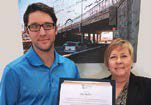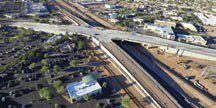Civil Spotlight: T.Y. Lin’s Heller Receives Special Award from Arizona DOT

This column in Informed Infrastructure aims to highlight a particular civil engineer or civil engineering project that received deserving credit for improving the profession.
Joseph (Joe) Heller, P.E., a T.Y. Lin International (TYLI) design engineer, received an Arizona Department of Transportation (ADOT) Partnering Spirit Award for the U.S. 60 and Bell Road Traffic Interchange Design-Build (D-B) project in Surprise, Ariz., which is near Phoenix and one of the fastest-growing suburbs in the United States. ADOT bestows Partnering Spirit Awards to individuals who played a significant role as members of partnerships achieving exceptionally positive results through agreements and productive working relationships.
Heller was nominated for the Partnering Spirit Award by ADOT’s General Engineering Consultant (GEC)/Oversight team. Serving as the main liaison between the D-B team and the GEC/Oversight team, Heller coordinated all designer/reviewer resolutions to comments and later served as the post-design engineer and a construction engineer for the contractor during construction.
Project Scope

A new Bell Road bridge over U.S. 60 replaced the previous ground-level intersection and crossing to increase safety and reduce congestion.
As the lead designer, TYLI was responsible for design management and coordination among the design team, ADOT, the contractor (Coffman Specialties Inc.), and other stakeholders. Scope of work included developing construction plans; final design services for the roadway, drainage, bridge and retaining walls; developing alternative concepts and quantities for a successful winning combination of bid estimate and schedule; and post-design services.
The U.S. 60 and Bell Road Interchange D-B project removed the state of Arizona’s third-busiest intersection and replaced the ground-level facility with a new median urban diamond (MUD) design. Constructed in a railroad right-of-way and along a major utility corridor, the project included a new bridge over U.S. 60 and adjacent BNSF Railway tracks, and 90,000 square feet of mechanically stabilized earth (MSE) walls. The accelerated, 13-month D-B schedule provided significant project cost and time savings.
Steve Elliott, assistant communications director for public information for Arizona DOT, explained that a number of factors went into deciding on the preferred alternative for the design of the interchange project.
“The MUD (medium urban diamond) design satisfies the traffic operational characteristics, provides the railroad grade separation, provides access between the two roadways and minimizes right-of-way and impacts to the neighboring commercial centers,” says Elliott. “Other interchange types would have required more land and more impacts to businesses.”
About Todd Danielson
Todd Danielson has been in trade technology media for more than 20 years, now the editorial director for V1 Media and all of its publications: Informed Infrastructure, Earth Imaging Journal, Sensors & Systems, Asian Surveying & Mapping, and the video news portal GeoSpatial Stream.


